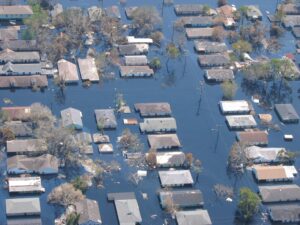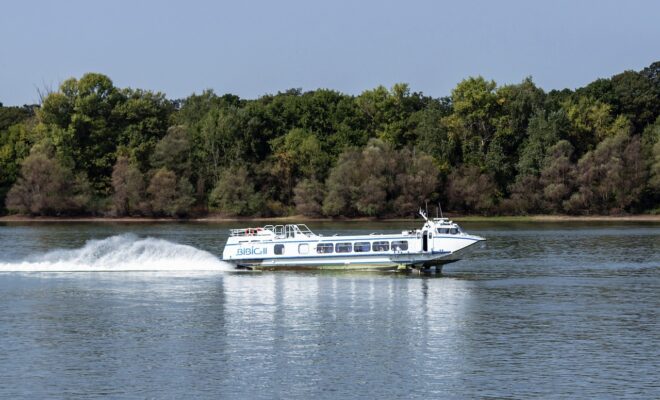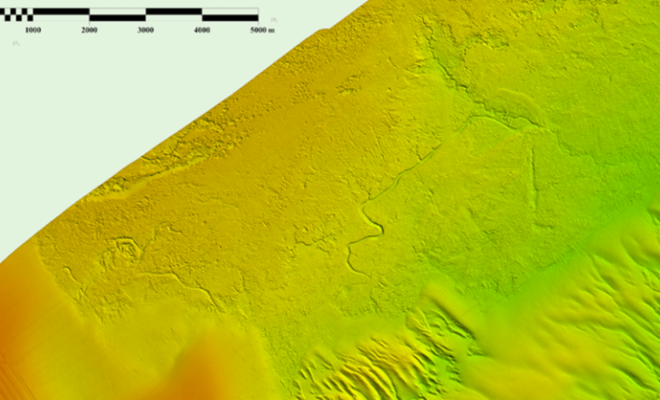At Mile 88 (101.2), Columbia River is joined by Willamette River, its largest tributary below the Cascade Mountains. The Willamette drains a large territory and is important as the site of the city of Portland, 9 (10.4) miles above its mouth.
The federal project depth in Willamette River is 40 feet to the Broadway Bridge in Portland, thence, maintained by the Port of Portland, 30 feet between Broadway Bridge and Ross Island. Additional information can be obtained from the Corps of Engineers, Portland, OR. Contact the Port of Portland for the controlling depths of the section of the channel maintained by the port.
From the entrance of the Willamette River to the Willamette Falls Locks at Oregon City, overhead clearances and depths are at Columbia River Datum. Above the Willamette Falls Locks depths of the Willamette River are at Willamette River Datum and clearances are at the datum of Newburg Pool.
Kelley Point Junction Light (45°39’11″N., 122°45’46″W.), 39 feet above the water, is shown from a pile structure with a red and green triangular daymark on the end of the dike extending from Kelley Point on the east side of the entrance to the river.
Columbia Slough, a narrow back channel roughly parallel to Columbia River, empties into the Willamette about 0.4 (0.5) mile above its mouth. Least depth in the slough is usually less than 2 feet. A dam has been constructed across the slough about 7.3 miles above the mouth. The fixed bridges over the slough have a least clearance of 15 feet. The least clearance of the overhead power and telephone cables is 42 feet. In the vicinity of Post Office Bar Range, 2 (2.4) miles above the mouth of Willamette River, deep-draft vessels favor the west side of the river, while smaller vessels and tows usually hug the east side because of lesser current. Overhead power cables with a least clearance of 230 feet cross the river 0.3 mile above the junction with Multnomah Channel. The twin towers supporting the cables are the most conspicuous features in this area.
Portland, on Willamette River about 9 (10.4) miles from its mouth, is the principal city of the Columbia River system and one of the major ports on the Pacific coast. The port has several deep-draft piers and wharves on both sides of the Willamette River between its junction with the Columbia and Ross Island. In addition there are extensive facilities for small vessels and barges south of Hawthorne Bridge and at North Portland Harbor, south of Hayden Island. It has extensive commerce, both foreign and domestic, and is the port of call for many lines of coastwise, intercoastal and transpacific vessels.
The Port of Portland, created by the state in 1891, is controlled by a Port Commission and administered by an executive director. The port owns several marine terminals, Port of Portland Ship Repair Yard, and dredges the channel between Broadway and Ross Island Bridges; it also assists the Corps of Engineers with other dredging in the Willamette and Columbia Rivers. The port also operates an international airport and three general aviation airports. A 30-inch hydraulic pipeline dredge is owned by the port. In addition to dredging the port waterfront and river channel, the port conducts hydrographic surveys periodically along all port-owned piers and wharves.
Anchorages
The anchorage areas that are generally used in the Columbia River are Kelley Point Anchorage, east of Kelley Point and on the southwest side of Vancouver Lower Channel and Hayden Island Anchorage, between the north end of Hayden Island and Vancouver Range. Hayden Island anchorage has three anchor buoys for use by bulk carriers/large vessels. A special anchorage in the Columbia River is between Tri-Club Island (Sand Island) and Lemon Island about 6.5 miles above the railroad bridge.
Regulated navigation areas
Regulated navigation areas have been established in the waters of the Willamette River along both sides of the river. These areas encompass sediment caps that have been placed over contaminated soil on the river bed. Anchoring, dredging or trawling in these areas is prohibited. See 33 CFR 165.1 through 165.13, 165.1322, 165.1323, 165.1326 and 165.1337, Chapter 2, for limits and regulations.
Caution
There are several cable and pipeline areas along the length of the Willamette River, the bulk of them being between Mile 2.6, near Multnomah Channel, through Mile 16.6, near the Sellwood Bridge. These areas are typically concentrated around bridge crossings; however, there are a few exceptions. A large cable and pipeline area, the northern limit of which is at Mile 11.4, extends southward to Mile 13.7, near the Ross Island Bridge. Not all submarine pipelines and cables are required to be buried, and those that were originally buried may have become exposed. Mariners are urged to use extreme caution in these areas. If anchorage is necessary, it is requested that vessel operators contact the Port of Portland before anchoring or performing construction activities.
Towage
Dock assist tugs to 3,600 hp are available in Portland. No lighterage is necessary, but occasionally lumber is transferred by barge from lumbermills to vessels.
Quarantine, customs, immigration and agricultural quarantine
Portland is a customs port of entry. Quarantine is enforced in accordance with regulations of the U.S. Public Health Service.
Coast Guard
A marine safety unit and station are located in the Swan Island Industrial Park at Portland.
Harbor regulations
The regulations are enforced by the City of Portland harbormaster and Multnomah County Sheriff River Patrol; copies of the regulations (Title 19) may be obtained on the Internet at portlandoregon.gov or, for a nominal fee, by contacting the City Auditors Office at 1221 SW 4th Avenue, Room 140, Portland, OR 97204. The harbormaster may be contacted by phone 503–823–3767 or by writing Portland Fire Bureau, Attn: Harbormaster, 55 SW Ash Street, Portland, OR 97204.
Wharves
The Port of Portland operates several modern marine terminals. In addition to the port-owned piers and wharves there are many privately owned deepwater facilities and many barge wharves in the harbor. Only the deep-draft facilities are listed in the facilities table. The alongside depths are reported depths. (For information on the latest depths contact the port authorities or the private operators.) All the Port of Portland operated facilities have rail trackage, water and electrical shore power connections, as well as many of the privately operated facilities. All wharves have highway connections. Floating and shore-based mobile cranes of up to 65-ton capacity are available, but most general cargo is handled by ship’s tackle. Special handling equipment, if available, is mentioned under Mechanical Handling Facilities in the table.
Supplies
Marine supplies of all kinds are available in Portland. Bunker fuel, diesel oil and lubricants are available. Most large vessels are bunkered at their berths by barge. Water is available at most of the berths.
Repairs
Portland is a major ship repair center on the Pacific coast. The Port of Portland, Swan Island Ship Repair Yard, on Swan Island on the east side of Willamette River, is the major repair facility at the Port of Portland. There are three floating drydocks here with a maximum lift capacity of 87,000 tons. Complete repair facilities and services are available at the yard, including construction, conversion and above and below waterline repairs. The yard has over 9,500 feet of ship repair berths to a maximum alongside draft of 40 feet (depending on river stage). There is a 157,050-barrel ballast treatment plant for the offloading of oily slops.
Several firms are available for undertaking outfitting and repair work. Marine railways with hauling capacities to 1,000 tons and cranes to 70 tons are available for full repairs and to any type of vessel.
Communications
Portland is served by several major railroads and airlines. Portland International Airport is about 2 miles north of the city. Many barge lines provide service up the Columbia River to Richland, WA., 214 miles from Portland; barge service is also available on the Willamette River to Salem, OR, 73.6 (84.7) miles above the mouth, and on the Snake River to Lewiston, ID, 324 miles from Portland.
Small-craft facilities
Most of the small-craft facilities, including practically all of the moorage, is in North Portland Harbor and along the south bank of the Columbia River between Interstate 5 highway bridge and the west end of Government Island. Complete facilities are available. Berths with electricity, gasoline, diesel fuel, water, ice, marine supplies, launching ramps, pumpout stations and wet and dry winter boat storage can be obtained at many marinas. Hull, engine and electronic repairs can be made. Drydocks to 70 tons, 55 feet long and 16 feet wide are available in North Portland Harbor.
Information from Coast Pilot: https://nauticalcharts.noaa.gov/publications/coast-pilot/files/cp7/CPB7_WEB.pdf. Chart reference: 18526.




